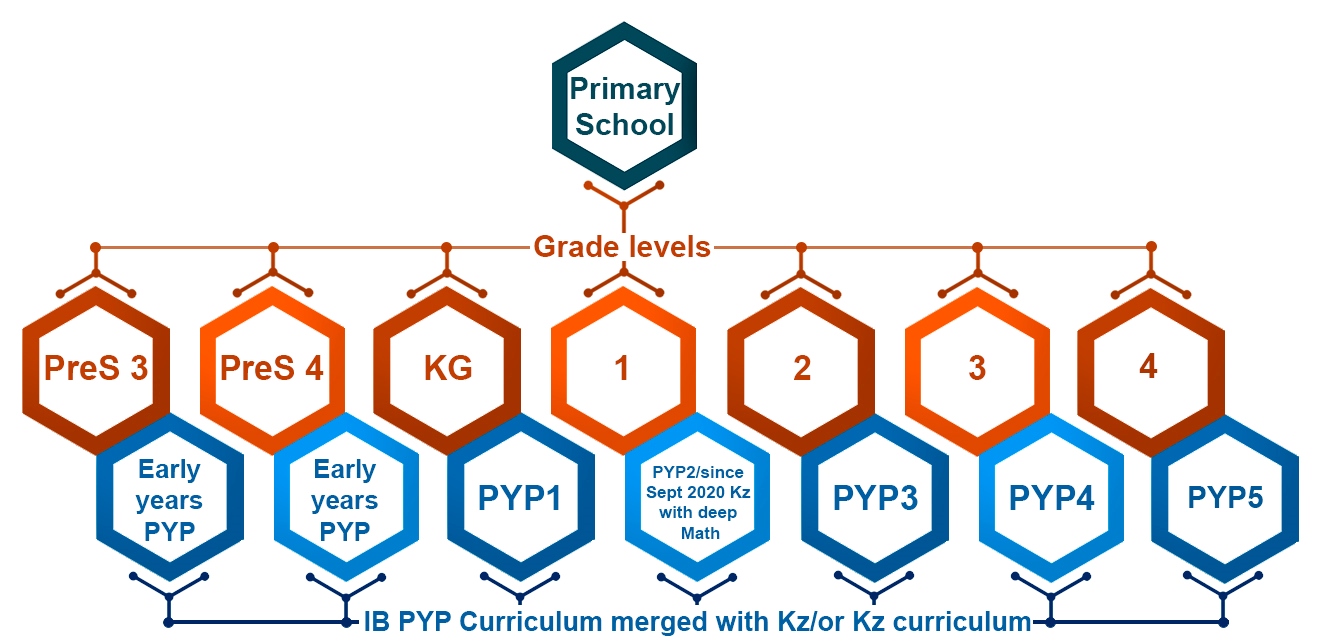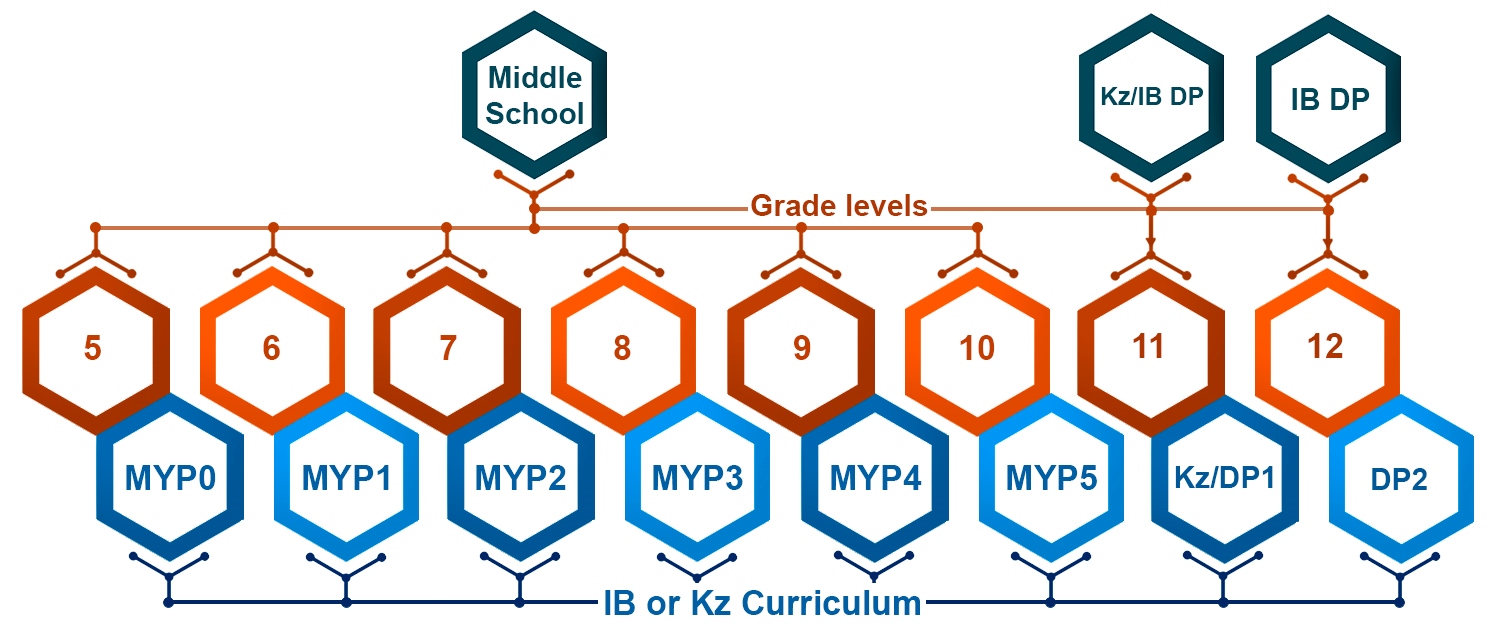Primary School Organisation
PS organization

The Pre-school integrates PYP early childhood and Kazakhstani standards caters for our three and four year old students. There are two three year old classes; A3, K3 and there are three four year old classes; A4, B4 and K4.
Kindergarten programme merges PYP1 and Kazakhstani requirements for five-six year old students. There are three KG classes; KGA, KGB, and KGC.
Grades 1 to 4 curriculum is based on PYP 2-5 and Kazakhstany standards for Primary school. We have a slightly different structure: in each grade there are options for students to work in Kazakh, Russian or English as their language of instruction.
Since September 2020 a class with deeper Math and Languages have been opened in KG and Grade 1 with Kazakhstani programme of education.
Primary School Curriculum
Miras International School merges the Kazakhstani State Educational Standards and the IB Primary Years Programme (PYP) to create a curriculum for students from three to ten-eleven years of age (Preschool to Grade 4).
The PYP is an international curriculum framework which focuses on the development of the child as an inquirer, both in the classroom and in the world outside. It encourages international-mindedness in students and a positive attitude to learning so that students become life-long learners. It emphasizes through the learner profile, the development of the whole child – physically, intellectually, emotionally and ethically. The IB Primary Years Programme guides us in what we teach, how we teach, and how we assess students’ learning. The main approach to teaching and learning is through inquiry, a process initiated by the student or teacher, which moves the student from his/her current level of understanding to a new deeper level.As we have an integrated curriculum. Our subject areas are often taught within the Programme of Inquiry, so students learn in meaningful contexts of:
Language A (Russian, Kazakh, English),
Language B (Russian, Kazakh, English),
Mathematics,
Social Studies and Science,
Visual Arts,
Music,
Information Computer Technology,
Physical Social and Personal Education (PSPE): Self-awareness, Physical Education (PE),Dance
For more detailed information about IBPYP, please visit www.ibo.org
In KG and Grade 1 groups with deeper Math and Languages Kazakahstany programme is enriched with Math Logics, Robotics, LEGO construction, Chess and English classes.
Secondary School
New teaching methodology and techniques are implemented in secondary school through the integration of Kazakhstani National Educational Standards and IB Philosophy and Requirements.
SS Organization

Middle school Grades 5-10
The programme which integrates Middle Years programme (IB MYP ) and Kazakhstani Educational Standards is designed for students aged 10-11 to 16 (Grade 5 -10).
MYP is a six years programme, it starts from MYP 0 (transfer year) for Grade 5 ends at MYP year5 for Grade 10. Grade 5 follows MYP 0 model based on the School integrated programme, adaptation to MYP programme and the acquaintance of MYP objectives. MYP 0 is serves as a preparation for MYP 1 in Grade 6, MYP year 1 objectives is modified for the year level of Grade 5 students.
This international programme is aimed at developing students' skills and knowledge to meet the requirements of modern society. Three Fundamental Concepts underpin the Middle Years Programme: holistic learning, intercultural awareness and communication.
The IB requires schools to teach a broad and balanced choice of subjects in every year of the programme. Curriculum guides published by the IB for every subject group, outline a framework of concepts and skills intended to provide direction and advice and ensure some worldwide commonality among MYP schools. MYP schools are required to structure their curriculum to allow students to achieve the aims and objectives of each subject group, confirmed by the IB in terms of final achievement at the end of the programme.
The subject areas are:
Language and Literature, the student's first language or language of instruction – English, Russian or Kazakh (taught in Grade 5-10)
Language Acquisition, an additional language(s) learnt at school – English, Russian, Kazakh and French
Sciences – taught as general science in Grade 5-7 and as three disciplines in Grades 8-10
Mathematics
Design
Individuals and Societies
Physical and Health Education
Arts – Visual Arts, Music and Performing Arts
Subject content is organized around themes or perspectives called Global Contexts. They are designed to encourage the students to make worthwhile connections between the real world and classroom learning.
Teaching and learning in the MYP involves understanding concepts in context. Global contexts provide a common language for powerful contextual learning, identifying specific settings, events or circumstances that provide more concrete perspectives for teaching and learning.
The six MYP Global Contexts inspire explorations of our common humanity and shared guardianship of the planet. They invite reflection on local, national and global communities, as well as the real-life issues and concerns of 10 to 16-year-old students. For each MYP unit, teachers should identify one global context that establishes a focus for meaningful teaching and learning in a program of international education. Over the course of their study, students should encounter all six global contexts, which are Identities and relationships, Orientation in time and space, Personal and cultural expression, Scientific and technical innovation, Globalization and sustainability, and Fairness and development.
After Grade 10 students can be admitted to the Grade 11 (Kazakhstani Programme) or Diploma Programme
MORE INFORMATION
The six Global Contexts are perspectives rather than specific subjects, and are not directly assessed nor awarded individual grades. They are indirectly assessed through the personal project, an independent piece of work that is intended to be the culmination of the student's sustained involvement with the six contexts. The personal project allows the student to complete a significant piece of work over an extended period of time, through a process led by the student with supervision by a teacher. The choice of type of project and its topic is made by the student in consultation with one or more of the MYP teachers responsible for supervising the project's execution according to IB-published guidelines. The personal project must be accompanied by a document in which the student describes the approach and the method that has been followed and provides a personal response to the issues concerned. The school uses published assessment criteria to assess the Personal project.
Student assessment within the Middle Years Programme consists of two types, each with a specific function.
Formative assessment is used to judge periodically the progress and effect of studies and see to what extent the objectives have been achieved. Teachers then make any adjustments necessary to their teaching methods and students can judge their progress, noting any gaps which remain. The purpose of formative assessment is to measure and assist the progress of the individual student. These are recorded using the student profile sheets.
Summative assessment takes place throughout the year, and typically at the end of each unit of work. The purpose of summative assessment is to show the achievement of the individual student in relation to the specific objectives. These assessment reveal the degree to which the student has mastered the stated objectives for a particular aspect of the MYP. All MYP assessment, whether formative or summative, is carried out by MYP teachers using assessment criteria established by the IB. Criteria are based on the published objectives of the groups and subjects. Currently, there are no formal externally set or externally marked examinations. The IB instead validates the standards of the authorised school's assessment through a process of external moderation.
Students in the RTS and KTS are assessed and levelled according to Kazakh standards in addition to MYP assessment. The level awarded is based on the MYP subject criteria. There is an adjustment scale as each subject has different achievement levels.
At the end of Grade 10, the award of course results and IBMYP certificate – formal documents certifying the student's performance in the MYP – is validated by the IB through eAssessment procedure. Final grades are awarded in line with either the results of online exams or ePortfolio data. The certificate is issued only to students who complete stated requirements.
At MIRAS we believe that effective assessment procedures can help develop clear and informative reporting, which in turn can support parents' involvement in their child's' education. The MYP has implied a need to assess the different skills involved in each subject more specifically, rather than relying only on examinations that lump together a wide range of skills. However, end of unit tests and an end of year testing might still be carried out. This should not be interpreted as a less rigorous approach than previously. If anything, the opposite is true. We expect subject teachers to continue to use regular and demanding tests, possibly at times testing work over the whole year. After completing the MYP, our students will enter the very demanding and "final examination" world of the IB Diploma programme. Clearly, they must be experienced in the management of time for revision and in dealing with the pressures of tests/exams, which cover a very wide range of work.
Grade 11 Kazakhstani Programme
Miras International School Curriculum for Grade 11 Kazakhstani Programme students merges Kazakh State standards and International approaches in Education. It is for students from 16 to 17 years of age. It encourages international-mindedness in students, independent inquiry and a positive attitude to learning so that students continue life-long approaches as learners.
It emphasizes through the learner profile, the development of the whole child – physically, intellectually, emotionally and ethically.
The curriculum consists of three interrelated parts:
• Written curriculum
• Taught curriculum (classroom practice)
• Assessed curriculum (assessment) according to criteria
To achieve a balanced and coherent curriculum, which focus on vertical articulation and links between MYP and Grade 11 Kazakhstani Programme students in Grade 11 Kazakhstani Programme are required to learn core subjects: Math, the first Language (Kazakh or Russian), the second language (Russian or Kazakh), Forign Language (English), ICT, History of Kazakhstan, PE, Self-Awareness and Military training. Two HL subjects should be chosen from humanities group: World History, Geography, Second Foreign Language or Lows Basics. Two subjects on SL chosen from Biology, Chemistry, Physics or Bases of Entrepreneurship and Business. There are some more courses might be chosen related to student’s university preparation.
Diploma programme Grades 11-12
“Miras” International School in Almaty was the first school in Kazakhstan authorised by the International Baccalaureate Organisation for the Diploma Programme (IB DP). The school has been authorised in 2002 and reauthorised in 2008 and 2013. 18 times our school celebrated DP Graduation Ceremonies. To date the highest total grade earned by our students is 45. Students are given the right to choose 6 subjects out of 6 subject groups, including the following: Geography, History, Arts, Business and Management, Economics, Biology, Chemistry, Physics, Mathematics (3 levels) and Languages (English, Russian, French and Chinese). Classes in three chosen subjects are taught on a higher level (240 academic hours) and other three subjects on the standard level (150 academic hours). In addition the programme has three core requirements that are included to broaden the educational experience and challenge students to apply their knowledge and understanding. These requirements are: the Extended Essay, Theory of Knowledge and Creativity Action Service. The DP course at Miras International School is taught in English.
Miras International School is international in its spirit, values as well as the student body and teaching staff, who represent 6 countries. Diploma programme teachers have a wealth of experience in the programme; many of them are IBO examiners. In Miras teaching methodology is constantly improved and developed. Our graduates study in the recognized universities around the world: USA, UK, Canada, France, Singapore, Switzerland and Turkey.
Those students who for some reason cannot study in DP will be proposed the Diploma Courses Programme.





